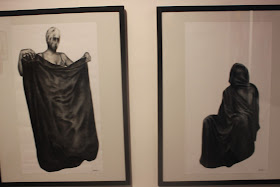Samantha Mugatsia as Kena and Sheila Munyiva as Ziki in Wanuri Kahui's Rafiki
WANURI’S ‘RAFIKI’ TO PREMIER AT CANNES
By Margaretta wa Gacheru (posted 25 April 2018)
Evidence
that Kenyan women playwrights and screenwriters are coming out in full force
has been most apparent in recent times. And not only with Zippy Okoth’s
original script, ‘Stranger in my Bed’ which she staged last weekend at PAWA254 or
with Mbeki Mwalimu’s recent co-authoring of ‘Stranger by Blood’ which she
collaborated on with Justin Miriichi a few days before. (Incidentally, Mbeki’s
directing ‘Mutual Misery’ this weekend, opening tonight at Alliance Francaise,
starring Melvin Alusa and Mary Mwikali.)
It’s also
not just because Lupita Nyong’o just announced she plans to put on her
filmmaker’s hat again to produce and star in Trevor Noah’s brilliant memoir,
‘Born a Crime.’
The biggest
news of the month is that ‘Rafiki’, Wanuri Kahiu’s latest feature film has just
been invited to premiere at this year’s 71st Cannes Film Festival which is
coming this next month.
It’s exciting news for many reasons but primarily because Rafiki is the first Kenyan feature film to receive such an invitation from the biggest and most prestigious film festival in the world.
It’s exciting news for many reasons but primarily because Rafiki is the first Kenyan feature film to receive such an invitation from the biggest and most prestigious film festival in the world.
But Wanuri
is also no stranger to award winning since she won the Independent Movie Award at
the Sundance Film Festival in 2010 for her post-apocalyptic eco-sci-fi film,
Pumzi. That was a huge achievement in itself.
But then,
Wanuri is not a woman content to rest on her laurels! She began work on
‘Rafiki’ shortly after she won at Sundance.
“I knew I
wanted to make an African love story,” Wanuri told BD Weekender. ‘And I thought
the love story between Kena and Ziki was a story I wanted to tell. It’s
touching, sweet and honest,” adds one of Kenya’s most prominent screenwriters,
director, and producer.
Ziki and Kena are best buddies who become rafiki
Ziki and Kena are best buddies who become rafiki
Wanuri’s
written the screenplay for ‘Rafiki’. But unlike the four other films that she’s
made since she completed a Masters degree in film from UCLA (University of
California at Los Angeles), she didn’t write the award-winning story on which
‘Rafiki’ is based.
That
accolade goes to another award-winning East African woman writer, Monica Arac
de Nyeko. The Uganda author won the Caine Prize for African Writing in 2007 for
her short story, ‘Jambula Tree’. The story, about best friends who fall in love,
had struck Wanuri for its honesty and sweetness. And as she had been looking to
base her next film on a love story, she felt it was “touching and sweet” enough
to inspire a full length feature.
The fact
that Kena and Ziki are both girls didn’t bother Wanuri even though she knew she
was creating a work that is about a ‘taboo-ed’ topic in much of Africa,
lesbianism.
“It took us
five years to make,” says Wanuri, who struggled, with the same issue that most
Kenyan filmmakers have, and that is funding. Ultimately, her film company,
‘Afrobubblegum’ got support from sources in France, Germany, the Netherlands,
Norway and even Lebanon. But it was a challenge.
The film
stars two young Kenyan women actors Sheila Muruiva and Samantha Mugtsia, and it
was filmed right here in Nairobi.
In a sense,
the fact that ‘Rafiki’ will be first shown in public in France rather than
Kenya is probably a blessing in disguise for Wanuri since her international
audience will undoubtedly have a more open-minded perspective on the subject of
women loving women than the average Kenyan.
But Wanuri
is clearly not disturbed by the blow-back she could receive from locals who
don’t understand or accept the concept of lesbianism.
An
international audience is bound to appreciate other aspects of the film than
the taboo. Plus what we have already seen from a film like Pumzi is that Wanuri
grapples with larger social concerns than those seen in petty foreign soaps
which still flood Kenyan airwaves.
Samantha Mugatsia plays Kena in this beautiful but bitter sweet love story
Samantha Mugatsia plays Kena in this beautiful but bitter sweet love story
For ‘Pumzi’
dealt with the real possibility of a post-water world (exacerbated by climate
change) that was meant to serve as a wake-up call and warning that radical
action is required if the human race is going to avert the disastrous effects
of our short-sighted lust for riches gained ‘by any means necessary.’
It’s no surprise
that the second film Wanuri made was a documentary film for MNET on the life
and vision of the great environmentalist Professor Wangari Maathai. Her
following film, “From a Whisper’ is still vividly etched in my mind because she
interpreted what human elements might have contributed to the disastrous
bombing of the American Embassy in 1998.
So we
eagerly await the opportunity to see ‘Rafiki’ ourselves and hope the voices for
free speech triumph over conservative forces bent on curtailing media freedom.












































